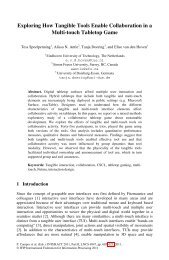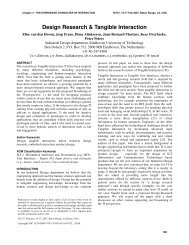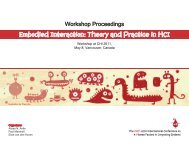Sissy - Elise van den Hoven
Sissy - Elise van den Hoven
Sissy - Elise van den Hoven
You also want an ePaper? Increase the reach of your titles
YUMPU automatically turns print PDFs into web optimized ePapers that Google loves.
notes and passages 45% stated the interface was<br />
reasonable and 55% indicated it enabled a little or none at<br />
all. This question generated a high level of commentary.<br />
These comments included the beat detracting from the<br />
activity as the need to follow it hampered expression.<br />
Two participants indicated the interface should use analog<br />
force data to allow potential sound modulation and better<br />
expression. The last response rele<strong>van</strong>t to this paper was<br />
based on the ascending arrangement of the note mapping.<br />
82% of respon<strong>den</strong>ts indicated that the mapping allowed<br />
for a reasonable playing of a musical passage and felt the<br />
arrangement could be learnt. Criticisms included the<br />
directions of keys were hard to follow and the frustration<br />
with having to use the legs instead of fingers, given by a<br />
regular piano player.<br />
Reflection on the design outcome<br />
In an attempt to understand the results we return to the<br />
initial design aims of the project. These were to provide<br />
sufficient physical information to support feet moving as<br />
note play, and to extend the piano spatial mappings for<br />
greater harmonic expression. Through these results it can<br />
be concluded that the inherent or felt experience of the<br />
interface was initially over designed. The dimpled rubber<br />
cover was not needed, as the compression provided by the<br />
foam between the timber layers was sufficient for the<br />
feedback on the note play. The coupling to the sound<br />
feedback was at a sufficient latency to encourage<br />
continual interaction but it was not dynamic enough to<br />
enable expression through the feet or bodily movement.<br />
Whilst it was a compromise to use the selected microcontrollers;<br />
we now know they were central to the<br />
expressive failure of the interface, due to their signal<br />
processing limits, even with our attempts to colour the<br />
note in the sound software. As a design quality the<br />
interface needs to allow for sound expression through<br />
subtle bodily movements, we cannot be compromised by<br />
technologies that do not deliver on this aim. Future work<br />
is needed on the redesign of either the electronic sensing<br />
method, the mechanical pad design, to allow for tilt for<br />
example, or both. We will also consult literature on<br />
methods and techniques to enable dynamic expression.<br />
In terms of the spatial mapping the results indicate that<br />
the Musical Staircase was largely successful. Comments<br />
indicated it was learnable and not too different from a<br />
piano or other chromatic mappings such as guitar fret<br />
boards.<br />
CONCLUSIONS<br />
This design process has been through once cycle of<br />
Framing the Problem, Design Response and User<br />
Evaluation based on the brief determined by the COM.<br />
Creating musically expressive public installations within<br />
challenging site conditions and budgets have major<br />
implications on the technologies that can be used and the<br />
interaction that can be offered. We intend to take the<br />
work further with a greater research focus on bodily<br />
movement and technologies required to leverage these for<br />
expressive interactive purposes.<br />
12<br />
Reflection on the process<br />
Examining the prece<strong>den</strong>ts to the Musical Stair indicated<br />
gaps in their potential for a physically expressive<br />
experience. This shortcoming we determined was due to<br />
the lack of inherent or physical information on the act of<br />
stepping and moving to create sounds. Add to this the<br />
need for a spatial mapping that allowed for more than a<br />
linear stepping pattern.<br />
We used this knowledge to frame our design efforts in<br />
realising the Musical Stair. The resultant prototype<br />
enabled user evaluation with an appropriate participant<br />
group. The questionnaire findings give an understanding<br />
of the general attitudes towards the Musical Staircase as<br />
enabling continuous interaction and expression. However<br />
little is yet understood about the movement quality<br />
afforded by the stair pads in terms of issues such as haptic<br />
feel and spatial affordance. To attain a finer grained<br />
understanding of these qualities will require further<br />
analysis of the video footage with particular focus on<br />
these qualities.<br />
Returning to the idea of reflective practice for movement<br />
and embodied interaction design we can see a very<br />
different process is needed to influence good decision<br />
making than would be used for conventional disciplines<br />
such as Architecture and Industrial Design. In our view<br />
designing for embodied and movement based interaction<br />
requires,<br />
• A robust model of the intended interaction,<br />
• An examination of any prece<strong>den</strong>ts against this<br />
model to develop a sophisticated framing of the<br />
problem<br />
• A design response through demonstration<br />
prototype<br />
• User evaluation of this prototype<br />
As interaction design deals in the temporal and<br />
experiential qualities of interfaces it requires user<br />
evaluation to give rich descriptions of these experiences<br />
through the usage of functioning prototypes. So to adapt<br />
Schön’s (1983) notion of reflective practice to embodied<br />
and movement based interaction the above steps need to<br />
be taken, not particularly in this order, to inform the<br />
design decisions and to reframe the subsequent iterations.<br />
We invite scrutiny on this model.<br />
REFERENCES<br />
Schön, D. The Reflective Practitioner. London: Basic<br />
Books, 1983.<br />
Ullmer, B , and H Ishii. "Emerging Frameworks for<br />
Tangible User Interfaces." IBM Systems Journal<br />
39, no. 3&4 (2000), 915-31.<br />
Wensveen, S, T Djajadiningrat , and C Overbeeke.<br />
"Interaction Frogger: A Design Framework to<br />
Couple Action and Function through Feedback<br />
and Feedforward." Paper presented at the<br />
Designing Interactive Systems, Cambridge, MA,<br />
2004.



![Download 1.8 MB [pdf] - Elise van den Hoven](https://img.yumpu.com/18078175/1/190x245/download-18-mb-pdf-elise-van-den-hoven.jpg?quality=85)

![Download 0.2 MB [pdf] - Elise van den Hoven](https://img.yumpu.com/18078145/1/182x260/download-02-mb-pdf-elise-van-den-hoven.jpg?quality=85)
![Download 0.1 MB [pdf] - Elise van den Hoven](https://img.yumpu.com/18078125/1/190x146/download-01-mb-pdf-elise-van-den-hoven.jpg?quality=85)
![Download 1.9 MB [pdf] - Elise van den Hoven](https://img.yumpu.com/18078041/1/182x260/download-19-mb-pdf-elise-van-den-hoven.jpg?quality=85)

